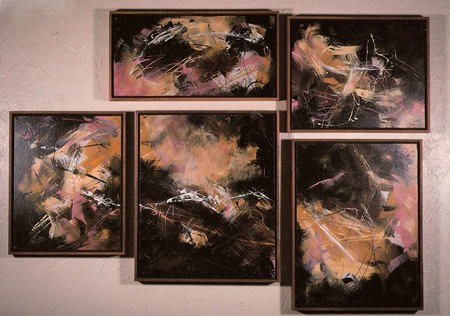Mahler's First
|
Mahler's First, 1976, 44"x65", acrylic collage, Dr. and Mrs. Casey
Rarely heard in its original five-movement composition, Mahler's First is, I feel, more expressive of his daring in this version than in the often-heard four-part rendition of the traditional symphony. Mahler was the first to incorporate the musical "no-no's" of disonance and atonality in his work. Because of scathing criticism, he eventually re-developed the Symphony and dropped the "Blumine" Andante--hoping for wider acceptance--yet his use of methods so far ahead of his time (yet so familiar to us today) was never well-received in his day. His statement, "it is really quite irrelevant what is represented. The only important thing is the mood that should be expressed," well describes my own ambitions for my "Mahler's First." In order to do his daring justice, I felt I had to use disonant taboos of the art world and make them "work." This is reflected in my choice of colors. Prime no-no's in colors on canvas are: black, pure white, pure cadmium yellow and, especially, pink. How could I possibly make anything worthwhile from such a color scheme? Yet I must! Because I also sense a deep earthiness in this symphony, I chose a deep earth brown to give the timbre. These colors, moving from one canvas to another, comprise the theme and variation aspect of the symphony and also interpret the "feel" of each movement: the Second (Blumine), which is light and dreamy, is lighter, airier in color; the Third, which is the most earthy, is in deeper earth tones. Sizes of the movements and placement are also important: the most expansive movements are the largest, the Second floats abive the earthy Third movement... again amidst the flow of color and pattern and the unifying bright (mostly white) sweeps gracefully from canvas to canvas to interpret the melodious, gracious quality of the Mahler.
|
| suites home | next suite | gallery |
